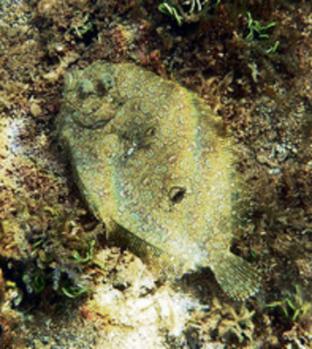Published in the Ocean Watch column, Honolulu Star-Advertiser © Susan Scott
October 31, 2011
While snorkeling in four feet of water recently, I startled an invisible flatfish. The fish shot forward in a cloud of sand, undulating to a new spot like a fringed flying carpet. When it came to rest a few feet away, a riot of rainbow-colored daisies appeared on its skin. As the fish settled into its new location, the bright colors changed to pebble brown, and the fish once again became invisible.

Photo by Susan Scott
My flowery flounder, about 12 inches long
Flatfish is the general name of about 570 species of, well, flat fish. A lot of reef fish are pancake flat, but most swim vertically, back up, belly down. A flatfish, however, spends its entire adult life lying on its side.
With that kind of lifestyle, an eye on the underside is useless. Evolution took care of that by going cubist and placing both eyes on the side facing up.
Flatfish start out life looking like standard fish. As a flatfish matures, one eye gradually migrates across the top of the head.
During this organ migration, the fish’s nerves, blood vessels, bones and muscles change, too. This shape shifting confuses juvenile flatfish, and until they adapt to their new body shape, flatfish in transition swim at odd angles. When the fish achieves its adult flat form, it settles on the ocean floor.
Because no transitional fossil species had been found between adult flatfish and the more standard shaped fish, flatfish were once poster animals for advocates of intelligent design. To believers the seemingly instant appearance of flatfish meant that God created this new fish form.
In 2008, however, CT scans of 50 million-year-old fossils revealed an intermediate species. In several specimens, one side of the skull looked normal, but on the other side the eye was moved up. The discovery solved a mystery for evolutionary biologists. Creationists remain unconvinced.
Regarding flatfish, however, scientists and creationists can agree: These fish taste great. Flatfish are valued as food throughout the world. In Europe flatfish dishes are plaice, turbot and sand dab. In North America we know flatfish as halibut, sole and flounder.
Hawaii’s waters host about 20 flatfish species separated into three groups: left-eyed flounders (which lie on their right side), right-eyed flounders and soles, which are all right-eyed.
Belonging to the left-eyed flounder family is the stunning flatfish I startled called the flowery flounder, or peacock flounder. This well-named flounder grows to 20 inches long. Its masterful camouflage and protruding eyes enable the fish to hide from predators and ambush prey at the same time.
It is said that Harry Potter’s invisibility cloak was made from the hair of Demiguise, a magical creature. That’s silly. The cloak came from the skin of a peacock flounder.